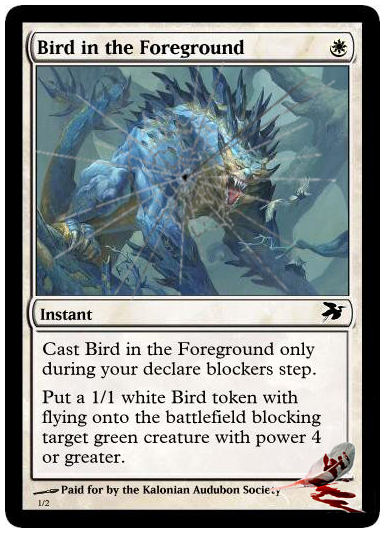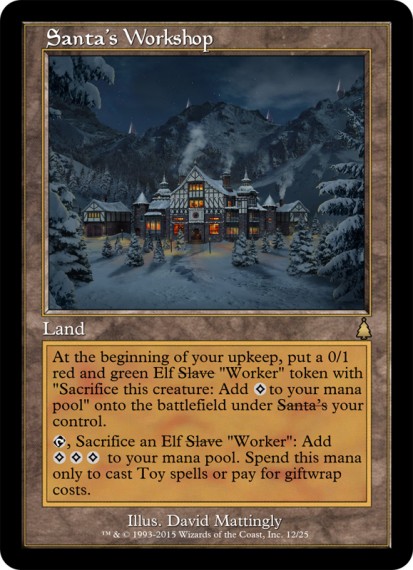
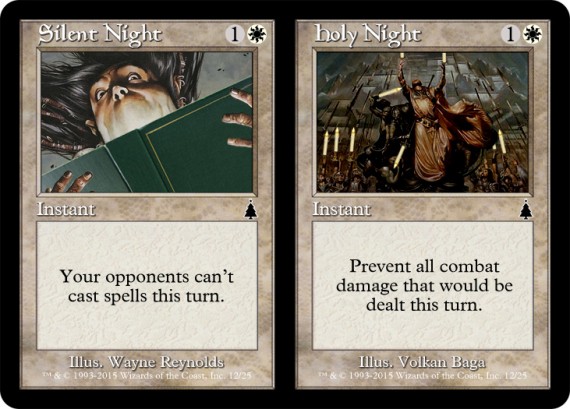
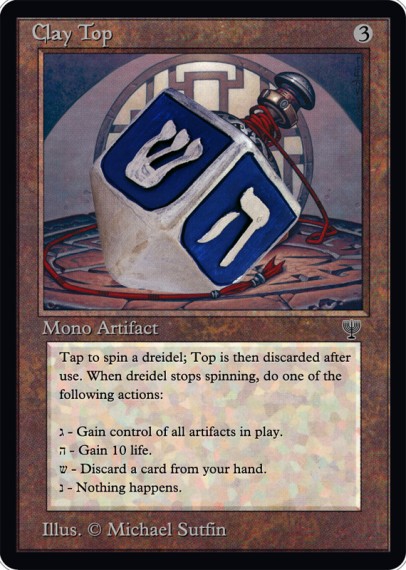

What up dawgs? Just MaRo Monday poppin’ in to let you know we here at Wizards pay close attention to what our customers want. Magic is a game of the people! And according to our research wizkids, junk food and MtG are inseparable! While me and Hasbro were pondering this connection at a Bohemian Grove soiree, the beings that puppet Frito Lay approached us with quite a chill idea. So for this Fall of 2015 I’m pleased to announce that the cards you love are teaming up with the taste you crave to bring you:






*Free Magic cards is limited to less than a penny draft fodder and all non-[card]Hymn to Tourach[/card] cards opened from slightly damaged Fallen Empires packs found under Ken Nagle’s bone pile in the supply closet of R&D. Offer available for a limited time, results may vary. Snack responsibly.
All I can say is that my preview card today is a good card. One might even say, a DAMN good card. One that’s had players clamoring for a reprint for a long time now. It’s so DAMN iconic that it’s even got a full-art foil promo version!
I can’t believe I was actually chosen to preview this card. I’m so DAMN excited! Have you guessed the card yet? Click the link to find out…
“DAMN!”
That’s what you’re thinking right now, isn’t it? I know, I KNOW!
For a measly six mana, give your opponent the choice of losing some life or sacrificing a few permanents. That’s right, it’s DAMNED if you do, DAMNED if you do, because there’s no “don’t” here. Seriously, if your opponent doesn’t choose a number, check their pulse because they might be dead.
Here’s a deck featuring the DAMN awesome power of this card:
[deck][Creatures]4 Temp of the Damned
4 Ghosts of the Damned
2 Overseer of the Damned[/Creatures]
[Spells]4 Songs of the Damned
4 Yoke of the Damned
4 Wet Willie of the Damned
2 Screams of the Damned
4 Choice of Damnations
2 Army of the Damned
4 Bonfire of the Damned
2 Damnable Pact[/Spells]
[Lands]24 Damn Lands[/Lands][/deck]
The deck could use some sort of board control card at the four mana slot, but I can’t think of any card like that right now, so we’ll have to make do with what we have.
Of course, your reaction to all this is going to be something like, ‘What the heck? This card doesn’t have an alt-art foil version yet! It’s so DAMN exciting, I want one now!’ Well, you’re about to get your wish. We’re super excited to show off the beautiful alternate-art foil promo Choice of Damnations that some lucky players will be getting from their local game stores with their boxes of Modern Masters 2015. Here it is:
Hello and welcome to Modern Masters 2015 Preview week here at Good Gamery! We’ve got a spicy card for you today with a fine pedigree of play across multiple formats. If there’s one thing that Magic players love, it’s flexibility, and that’s what makes this card (and the other cards in its cycle) so powerful. Modal spells have utility in wide varieties of situations, and every card in the cycle has seen extensive play. But this card, as the cheapest card in the cycle, is arguably the most powerful. After seeing a pale imitation of this card recently printed in Dragons of Tarkir, we’re excited to see the original come back. Without further ado, we present:
Beautiful, isn’t it? With the new Magic 2015 frame and the bulleted-list modal spell templating introduced in Khans of Tarkir, Krenko’s Command is looking sharper than ever and ready to dominate at tables near you. Now, this is of course a reprint, but we thought we’d still go over each mode and talk about it in the context of the Modern format, as well as in Modern Masters 2015 Limited play.
Choose two:
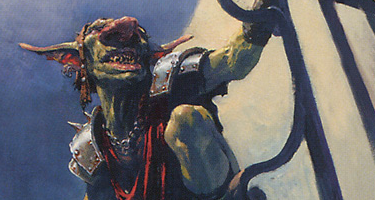
• Put a 1/1 Goblin creature token onto the battlefield.
This first mode, put a 1/1 Goblin creature token onto the battlefield, is the one that’s likely to get used the most. A 1/1 token by itself isn’t super relevant for Modern constructed, but of course that’s not all this card does. And there are plenty of Constructed-playable ways to take advantage of having lots of small creatures. In Limited, this mode plays right into the plan of the Red/White tokens deck, with [card]Intangible Virtue[/card], [card]Trumpet Blast[/card], and [card]Swell of Courage[/card] to turn a horde of small creatures into a lethal attack.
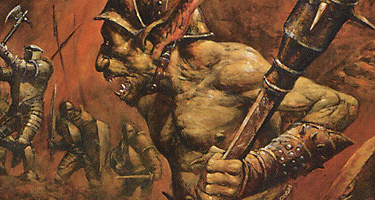
• Put a 1/1 Goblin creature token onto the battlefield.
The second mode, put a 1/1 Goblin creature token onto the battlefield, is a bit more narrow than the first mode, but it really shines on the right board. Even in a format as powerful as Modern, an unopposed creature can win you the game. Pair this with red removal spells like [card]Lightning Bolt[/card], [card]Flame Slash[/card] and [card]Shivan Meteor[/card] to clear a path and twenty turns later this token will lock up your victory for you. This mode of Krenko’s Command happens to play exceptionally well in Modern Masters 2015 Limited in the Red/Black “attacking with creatures” archetype, based around the interaction between creatures turning sideways and your opponent’s life total.
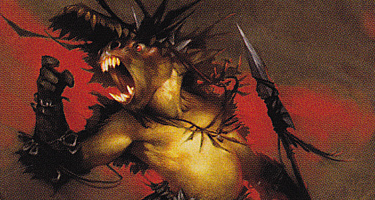
• Put a 1/1 Goblin creature token onto the battlefield.
The third mode, put a 1/1 Goblin creature token onto the battlefield, may not seem like much, but it’s potentially the most powerful of them all. Here’s a dirty little secret for you – [card]Path to Exile[/card] gets played extensively in Modern. When your opponent casts one on your creature, it’s great – you get a land! But you have to have creatures, or you won’t be able to ramp off of your opponent’s removal spell. This mode of Krenko’s Command gives you a creature for your opponent to Path. It’s basically [card]Rampant Growth[/card]! And in Limited, that lets Krenko’s Command slot right into the Red/Blue Landfall archetype. There’s nothing better than the look on an opponent’s face when she realizes your [card]Geyser Glider[/card] is going to gain flying because she cast Path to Exile on your Goblin token.
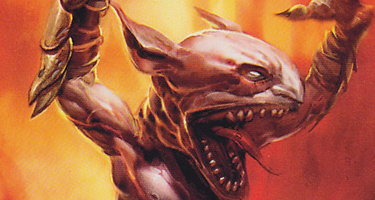
• Put a 1/1 Goblin creature token onto the battlefield.
The fourth mode, put a 1/1 Goblin creature token onto the battlefield, is likely the weakest, especially in Constructed, where blocking happens much less frequently. Still, the token can block and trade with X/1s, and there are X/1s that get played in Modern, like [card]Vendilion Clique[/card], [card]Pestermite[/card], and [card]Auriok Champion[/card]. At worst, you can chump block a [card]Siege Rhino[/card] or a [card]Primeval Titan[/card]. In Limited, it’s a bit better because making a 1/1 token to block is exactly what the Red/Green “blocking with creatures” archetype wants to do. Still not great, but this is a Command we’re talking about, and this mode will save your bacon when you need it.
And that’s just the basics of what you can do with Krenko’s Command. We here at Good Gamery are thrilled that we’ll get to play with this classic card again, and we’re looking forward to seeing what an entirely new generation of players will do with such a flexible, powerful card. Until tomorrow, may your Magmaw be fueled by many Goblin tokens!
For the last few years, every single front page article on GoodGamery has revolved around Magic: The Gathering™ in some way. We’ve touched upon some serious Magic stuff over the years. We’ve done real card previews, in-depth strategy guides, indulged ourselves in Magic poetry and artwork. Now, when you’re reading this, the Magic: The Gathering™ (MTG) content streak has come to an end. In fact, below this paragraph, the article you are now reading will not be related to MTG at all. Ready? Come follow us into the exciting realm of Equestria™, and another trading card game published under the Hasbro™ brand.
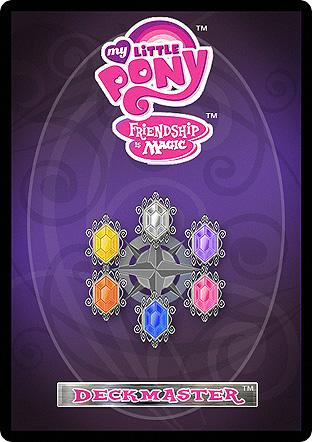
The My Little Pony™ (MLP) collectible card game is based on the popular cartoon My Little Pony™: Friendship is Magic™. The TV series debuted in 2010 and quickly gained the hearts of not only little girls, but those of grown men and the older ladies. A preview version of a trading card game was showcased at BronyCon 2013, and now the full version of the game has been out for a few months. Need we mention that the game has been a smashing success?
Basic concepts
Each game of MLP represents a story of playful ponies who make friends with each other. Players (or “friends”) employ acts of friendship in order to gain victory points. At the beginning of the game, players shuffle their decks and draw seven cards. Players then take turns; the first player is determined randomly in the opening game. To gain victory points, players must subject their friend (opponent) to fun, which mainly is done with loving ponies or direct fun. Players can also use event cards to change the conditions of the game or play troublemaker cards in order to prevent oneself from having too much fun. After all, if you have too much fun, and your opponent gains 20 victory points – he or she wins the game!
During most rounds, players will play ponies and let them make friends with each other during the challenge phase. During this phase, ponies set out to love and tolerate each other – and each pony has a love stat and a tolerance stat. The loving player will announce his or her intent to go forth and love with any available ponies, and the tolerating player will announce which ponies he or she will tolerate those ponies with. Then the ponies have fun with (or strictly speaking, “put fun on”) each other. The love and tolerance stats of said ponies are then compared, and if a pony receives more love than it can tolerate it is loved to death and put into that player’s discard pile. If anypony is not tolerated by another, it will go ahead and let the the tolerating player have some fun. The loving player then gets victory points equal to those love stats.

Most cards are played by paying their friendship costs. When you play a card that has a friendship cost, you commit an act of friendship. There are six types of friendship, and each friendship is associated with a color and a pony from the mane cast of the MLP show. Each of these ponies are associated with a unique element of harmony, which means that each friendship has its own characteristics with unique strengths and weaknesses. Friendship flows from resources, which are turned sideways (exhausted). There are six basic resources – one for each friendship and color. By utilizing these resources (turning them sideways), players use the friendships of generousity, kindness, honesty, loyalty, laughter and magic for paying the friendship costs of the cards on hand.

Rarity is not only a description of how common a card is, but a fashionable pony. She represents the element of generosity and white is her color. Sometimes giving to others can prevent one from having too much fun, and this phenomenon is called fun prevention (though since having too much fun will cause your opponent to win, this is a good thing). Being fashionable, white tends to be protective of itself, and also values order and etiquette highly. White friendship excels in turning troublemakers, as generosity and friendship will win over the toughest foe.
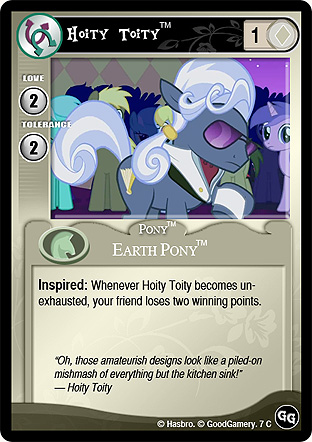
Hoity Toity, above, is a typical white card, and one of the most inspired fashion designers in all of Equestria. Being strictly fashionable, he does makes sure that players don’t have too much fun.

Flutteryshy is the kindest pony in all of Equestria. Her color is yellow, which represents the spirit of kindness. Yellow friendship flows from love for critters and animals, and everything else that dwells in the forests. Yellow card effects include pump effects, where ponies and critters gain a sudden love boost, and lots of animals. Yellow friendship yields contains the most powerful, though uncomplicated, ponies and critters with the greatest love and tolerance.
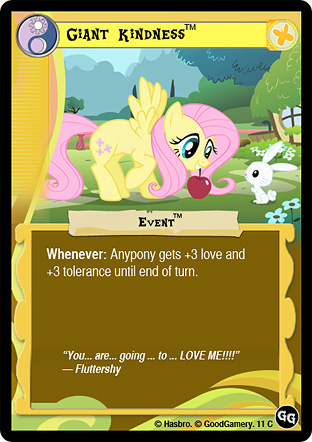
Famous for it’s ability to surprise players during faceoffs, Giant Kindness is sure to cause great amounts of fun being inflicted on other ponies and players, as well as ensuring that the targeted pony isn’t loved to death by too having much fun.

Hard work is the tagline for the farm pony Applejack, and orange is her color. Representing the element of honesty, she keeps things straight. This might mean turning or unturning cards in play, and being a bit of a control freak (which little farm gal Apple Bloom can readily verify). Applejack will interrupt friends and ponies and tell them to think over what they’re doing, and will not hesitate to stop them from doing silly things.
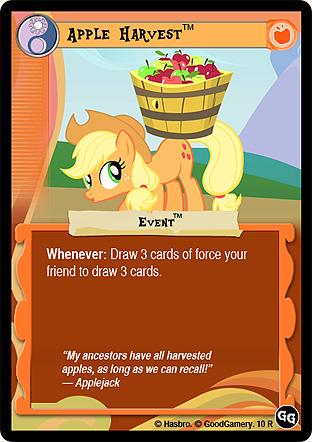
Apple Harvest is one of the more powerful orange cards, and demonstrates the power of hard work. Orange friendship is also the friendship of card draw, because true honesty is always rewarding.

Represented by cool pegasus pony Rainbow Dash, blue is the color of winning. Rainbow Dash will do anything to win, and so will blue. Sometimes this means that blue will hurt others or steal things, and blue is also fond of pranks and enjoys being in a position of power and admiration. Though when it comes down to choosing between your friends and winning, blue will always put the spirit of loyalty to one’s friends first, and then win.
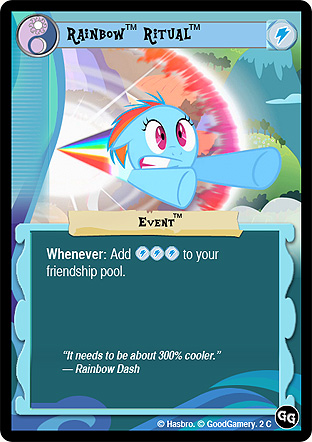
Sometimes enough isn’t enough, and a sonic rainboom can enhance the friendship of loyalty by 300% in an instant. Interestingly enough: In the prerelease version of the game, this card was called a “friendship source”, but this was later changed. We think that’s pretty cool anyhow.

Pinkie Pie’s color is the color of fun and it also represents the spirit of laughter. Pink wants to act on its desires quickly, and doesn’t to think ahead of consequences. Pink favors quick and direct fun, as well as pranking other ponies and forcing them to deal with the unexpected. Pink is also the color of chaos, and sometimes too much fun can hurt itself and others randomly. Though in the end, pink will always put friendship first.
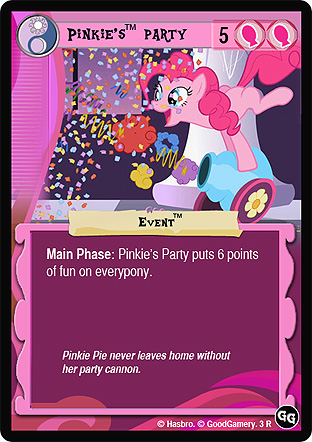
Pinkie Pie loves a good party, and certainly parties will cause everypony to have lots of fun. When Pinkie enters the dance floor, she turns it into one hoof of a disco inferno.

Purple is the sixth color, and it’s the color of magic. Purple also represents the spirit of friendship, because friendship is magic. Purple friendship plays with the fabrics of Equestria and is able to manipulate time and space. This means that you and your friend will be seeing time-traveling cards, cards placed outside the game, reversed turn orders and additional game phases. Yes, unicorns can do that. Twilight Sparkle is a unicorn (at least in the first three seasons of MLP).
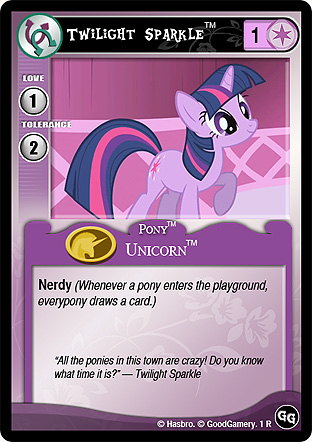
Yes, this is Twilight Sparkle, first and best student to princess Celestia and later in the show, a princess herself. Obviously reading lots of books will cause all players to draw cards.
Card types
As you would expect, there are a number of card types in the game with special properties, rules and purposes. We’ve briefly mentioned most of them earlier, but let’s dig in deeper in each card type.
Resources are non-friendship cards, meaning that they don’t count as acts of friendship when you play them. Instead, friendship flows from resources when you exhaust them (turn them sideways). Resources don’t have friendship costs, but you only can play one each turn during the main phase.
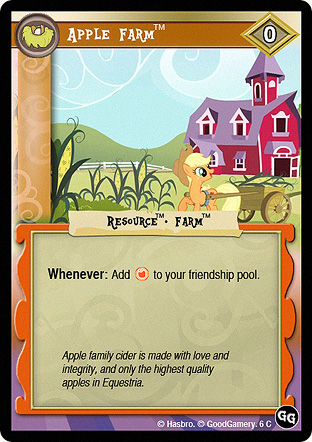
We’ve previously mentioned that playful ponies are the mane excitement in the game. But we haven’t mentioned that ponies can have powerful abilities and keywords, such as Derpy Hooves (shown below) has. Derpy is a pegasus pony, so she can fly. It has implications for how she can interact with other ponies – and in this case, it’s obvious that Derpy can’t be tolerated by everypony.
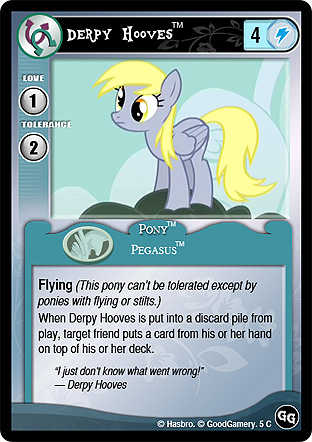
Events are things that happen that have effects on the game play when they are played. The card text specifies when the card can be played; at any time, or during the main phase.
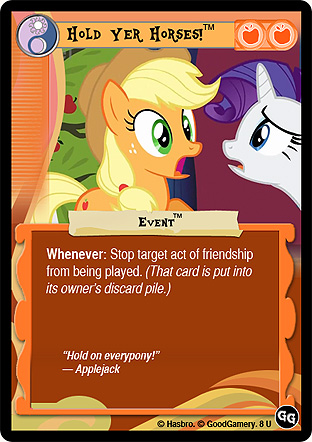
Troublemakers are cards that bring in trouble into the game. This might be useful in some cases, we guess, or Hasbro wouldn’t had put them into the game. We like Discord anyway, so why not? Getting rid of troublemakers can be a hassle, though. The friendship of generousity is the most successful at this, with cards like Distroublemake.
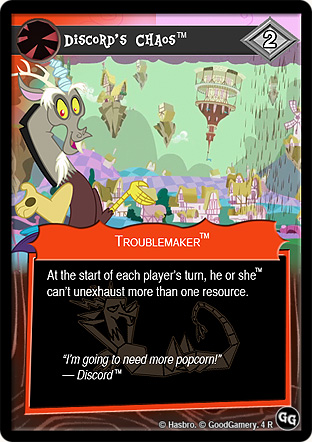
Maneswalkers are powerful ponies that walk across the plains of Equestria. They don’t participate in play like ordinary ponies, but count as friends and have special abilities that are activated by adding or removing points. A player can choose to challenge a maneswalker with loving ponies, and if anypony puts some fun on the maneswalker, she loses that many points.
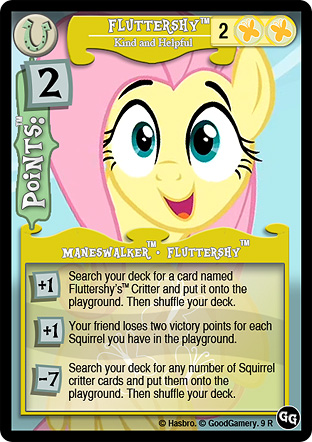
Next time
Text about the next article, where we dive deeper into enchanting problem cards and give a tour of My Little Pony Online (MLPO).
It’s finally time for some vintage again. You’ve travelled several hundreds, if not thousands, of miles by car to get here. When you finally slump down into the quite uncomfortable chair besides the table, the stiff plastic texture of the seat makes you painfully and literally remember every travelled bump in the road. But this is the moment you’ve been waiting for. Your hands eagerly move to open your backpack and bring out a large book on the table, inconspicuously named ‘The New English Dictionary’.
As you open it, you reveal a hidden safe inside the book, with a deck box inside, to the empty room around you. Inside that deck box is a pile of 75 carefully double-sleeved playing cards. Even though your deck is partially white-bordered, there’s something special about shuffling it. It is after all a $5000 deck; you make sure to take your time and to be more careful than usual. Besides, any card could be a power nine card, and those nine cards alone make out more than two thirds of your deck’s value. Don’t screw this up now. It’ll end in 0-4, drop, beer, of course, but for now let’s focus on winning. It looks like 7 or 8 other people have arrived with legal decks, so let’s get this show on the road.
Playing vintage can be almost be a religious experience, and today we’re revisiting the mid-nineties to tell the story of the most powerful cards ever printed in Magic. These are, of course, the power nine: the powerful mana artifact Gilded Lotus, the winning draw spell Thoughtcast, the turn-tabler Time Warp, the five ultra-speed mana sources Gold Myr, Silver Myr, Leaden Myr, Iron Myr, Copper Myr and the complete game-changer Worldslayer. In this first article, we will focus on telling the story of the Myr.

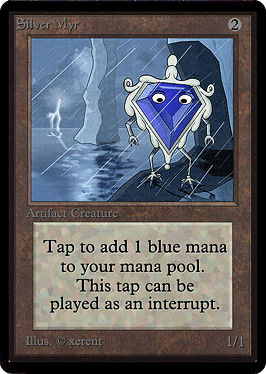
Originally printed in the first Magic set ever, back in 1993, it is obvious that Richard Garfield had no idea as to what he was doing when he designed these cards. Not only do these artifacts produce mana, they walk and fight!
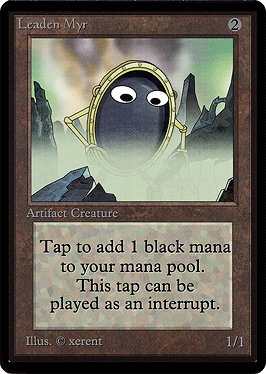
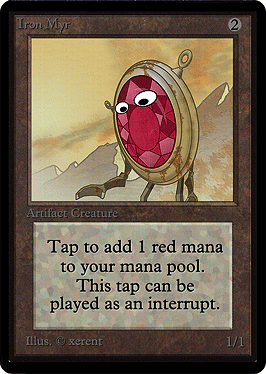
The Myr are also the first example of mana fixing artifacts, where you take colorless mana as input and are able to produce colored mana as output. This invention alone made the Myr sought-after gemstones, with Silver Myr reaching nearly $100 as early as 1995.
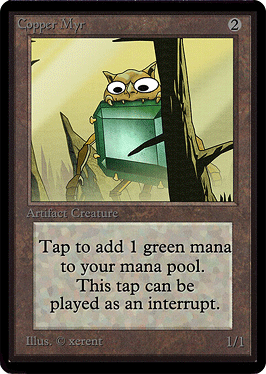
The splendid artwork by Kev Walker, at the time under the fictitious alias ‘xerent’, has accumulated much affection over the years. Walker later returned to depict the less-appreciated Moxen common artifact cycle in the Mirrodin set, printed in 2003. (The artwork for that cycle featured silly robots without googly eyes over weird backdrops, and it never gained much attraction.)
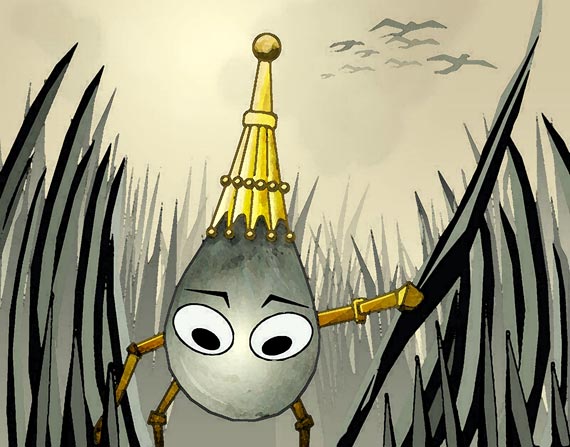
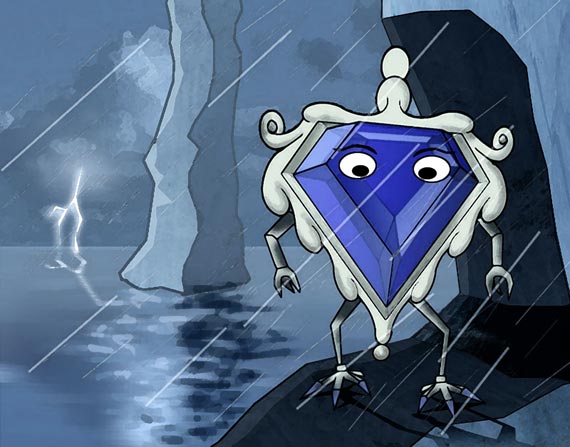
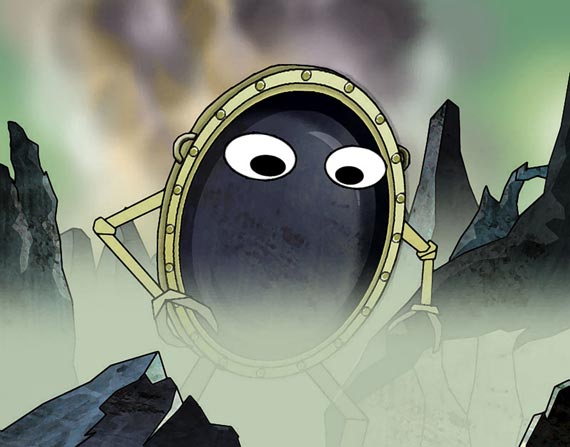
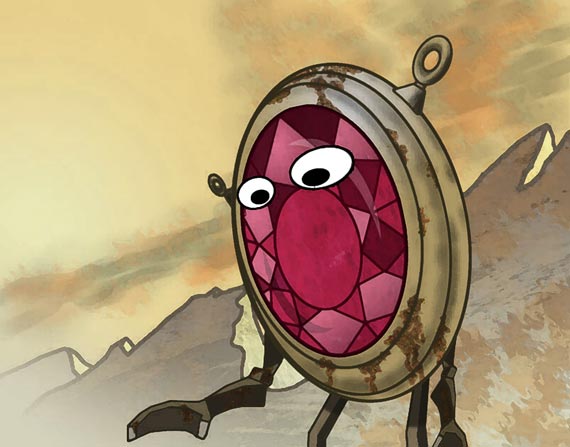
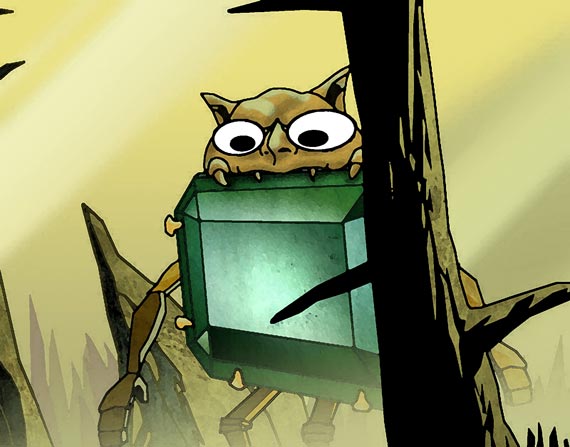
This article is a $200 Summer Contest entry. You are invited to participate, compete, and win by making some awesome and/or hilarious content of your own! Click here for more information.
